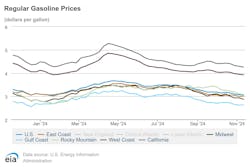Gas and diesel costs continue incremental decrease, diesel $3.52/gal
Diesel and fuel prices have continued to trend downward across the U.S., according to the U.S. Energy Information Administration, with most regions, especially the East Coast, Midwest, and Rocky Mountains, seeing less and less disparity between their rates since July. The average U.S. on-highway diesel price sits at the center of this pricing cluster, with this week’s average reaching $3.521 per gallon, only 1 cent lower than last week and 77 cents lower than this time last year.
But while diesel prices have been relatively consistent in their decrease, this week’s drop was relatively sluggish, with price changes largely mirroring the national average at 1 cent. Even the only area to see a diesel cost increase, the Central Atlantic sub-region, experienced a cost increase of 1 cent to $3.807.
Otherwise, the West Coast without California saw their diesel prices dip less than a cent to $3.757 per gallon. With a slightly larger price drop, the East Coast, Midwest, Gulf Coast, West Coast, and California all experienced diesel price cuts of 1 cent. This resulted in average diesel prices of $3.579 for the East Coast, $3.504 for the Midwest, $3.170 for the Gulf Coast, $4.180 for the West Coast, and $4.666 for California. The Rocky Mountain region was the rare outlier this week with a price cut of nearly 6 cents to $3.525.
However, price changes of 1 cent were not enough to shift which regions have the cheapest and most expensive diesel fuel, with those titles remaining with the Gulf Coast and California, respectively.
See also: Fuel prices continue to creep lower across U.S.
For comparison, the AAA motor club logged diesel prices 2 cents more expensive than the EIA’s this week at $3.547. The AAA’s current diesel costs are also 2 cents cheaper than last week’s number, and 81 cents cheaper than last year’s.
Gas cost average inches toward $3/gal
While gasoline had a few more regions that experienced price increases than diesel, costs overall have continued to trend downward as demand recedes, and by equally small numbers as diesel costs. Nationwide, the average for gas prices is $3.052 according to the EIA, reflecting a 1-cent price drop from last week and a 29-cent price cut from this time last year. Otherwise, gas cost shifts tended to vary from 1-7 cents.
For regions that did see their gas costs increase, both the East Coast and the Gulf Coast saw prices rise by 1 cent to $3.002 and $2.630 per gallon. Meanwhile, prices fell 1 cent along the West Coast without California to $3.565, 2 cents along the West Coast overall to $3.924, and 2 cents along the Rocky Mountain region to $3.075. On the higher end, California saw its gas prices drop 3 cents to $4.253, and the Midwest benefitted from a 7-cent price dip to reach $2.866 per gallon. But once all’s said and done, this still leaves the Gulf Coast as the cheapest place for gas at $2.630, and California at the most expensive at $4.253 per gallon.
In comparison, the AAA’s gas average is currently 2 cents more expensive than the EIA’s and 3 cents cheaper than last week’s at $3.078. This also leaves today’s prices much better off than this time last year’s of $3.369 per gallon. While the motor club anticipated that Hurricane Rafael could stop gasoline’s slow descent last week, this threat did not materialize.
“Gas prices often freeze as a hurricane enters the gulf and oil production and refining are threatened,” said Andrew Gross, AAA spokesperson. “But once Hurricane Rafael passes, pump prices should soon regain their downward momentum.”
About the Author
Alex Keenan
Alex Keenan has been associate editor for Endeavor's Commercial Vehicle Group, which includes FleetOwner magazine, since 2022. She has written on a variety of topics for the past several years and recently joined the transportation industry, reviewing content covering technician challenges and breaking industry news. She holds a bachelor's degree in English from Colorado State University in Fort Collins, Colorado.


